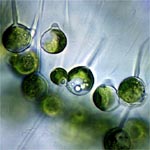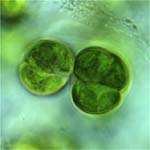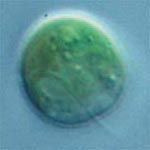Charales (roughly 300 species)
The Charales are large, structurally complex algae found primarily in freshwater, but also in brackish, and semi-terrestrial environments. They range in size from a few millimeters to over a meter in length, and consist of a complex set of branching filaments. Internodes are unicellular (but may be covered by a subsequent growth of corticating filaments) while nodes have a complex, parenchyma-like organization. The Charales have an excellent fossil record extending back far over 420 million years, and two extant lineages, the Characeae and Nitellaceae, can be traced back roughly 200 million years.

![[M145.2 = KGK0054c]](Strp/N.tenuissima150.jpg)
The Coleochaetales are microscopic but structurally complex algae found exculsively in freshwater. They are composed of branched filaments, which may be arranged in a three-dimensional cushion ("pulvinate") or two dimensional disk. In some the filaments are laterally joined. Asexual reproduction is by the formation of zoospores. Sexual reproduction in Coleochaete is oogamous, and the zygote is retained on the parental thallus. There is reason to believe that the developing zygote obtains nutrients from the parental thallus. Like Coleochaete, the genus Chaetosphaeridium is composed of branched filaments, but the filaments enlongate and the connections between cells are so tenuous that it is often confused with colonial growth.


Zygnematales (roughly 3800 species)
The Zygnematales are either unbranched filaments (although a few species form one or a few branches early in development while they are forming a holdfast) or unicells. In some cases (the desmidiaceae) the cells are divided into distinct semicells. There is reason to believe that the unicellular members of the Zygnematales are derived from filamentous ancestors. Chloroplast shape differs markedly among genera and species, and the elaborate chloroplasts are often quite beautiful. There are no flagellate stages, but some are capable of gliding mobility. Sexual reproduction occurs through a process of conjugation, in which gametes travel via amoeboid movement. The Zygnematales are a diverse and ecologically important group.
Spirogyra maxima UTEX2495; filaments 100-150 µm dia.
![[CSD m144.36]](Strp/SpiroMax150.jpg)
Spirogyra maxima
Klebsormidiales (roughly 15 species)
The Klebsormidiales are freshwater or terrestrial algae composed of unbranched filaments that may dissociate into short segments called hormogonia. They are common on rocks and concrete in moist climates, and can often be found forming a green film near drinking fountains, hose spigots, and in permanently shaded areas. Zoospores are produced one per cell, have two laterally inserted subapical flagella, and do not have an eyespot. Zoospores are discharged from a specialized pore or operculum, and the structure of this pore is important in identification of species. Sexual reproduction is not known.

Chlorokybales (1 species)
Chlorokybus atmosphiticus is a rare soil alga, and has only occasionally been found in nature. It is composed of small clusters of cells (i.e., is sarcinoid). It produces one zoospore per cell, with two laterally inserted flagella associated with a groove. Unlike other charophytes that produce zoospores, zoospore release involves complete digestion of the parental cell wall rather than formation of a pore.
Both structural and molecular phylogenetic studies support its placement as one of the first branches on the charophyte lineage.

Mesostimatales (1 species)
Mesostigma viride is a unicellular scaly flagellate that some authors have placed among the charophytes. Molecular phylogenetic studies have produced conflicting results, and its current phylogenetic placement is unclear. It is treated here because it might be a member of the charophytes, and because it has been an important organism in discussions of the evolutionary origin of charophytes.


Body Scales (Chappell & Ris)